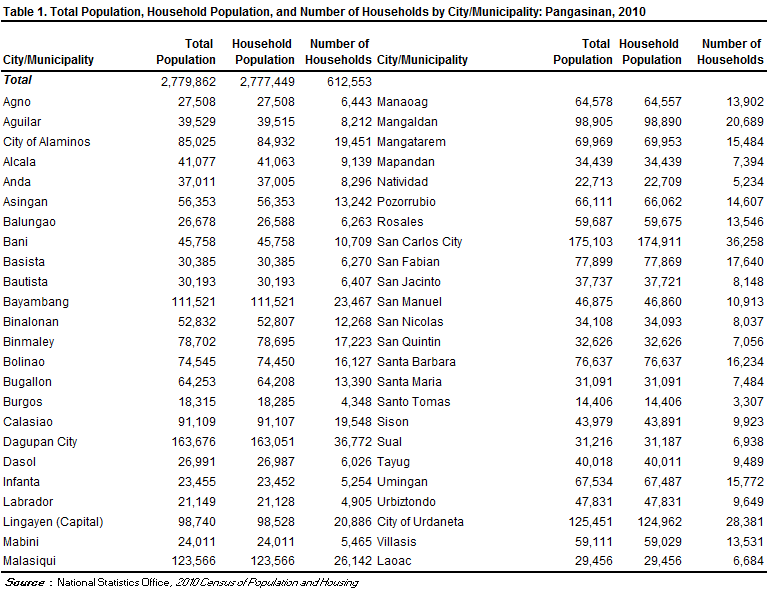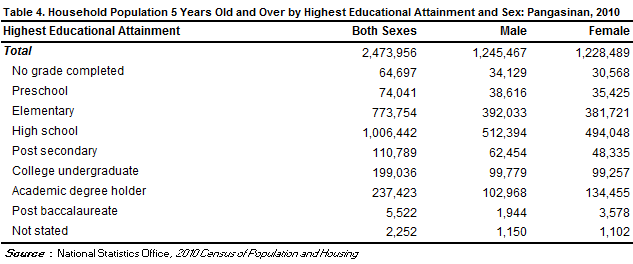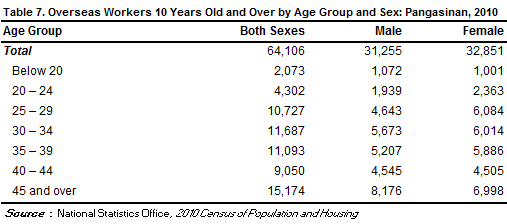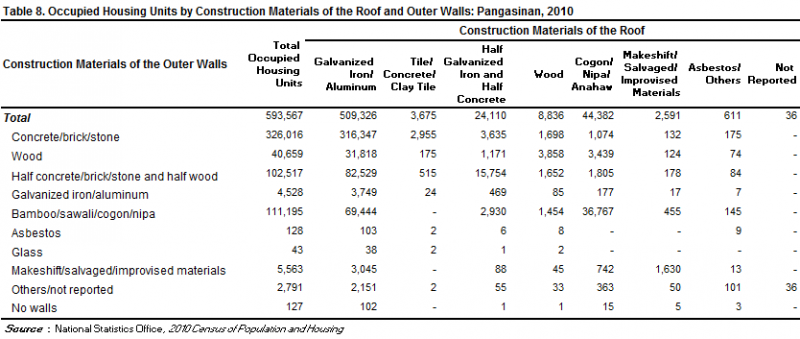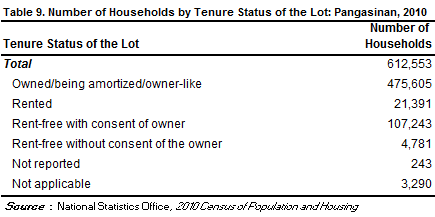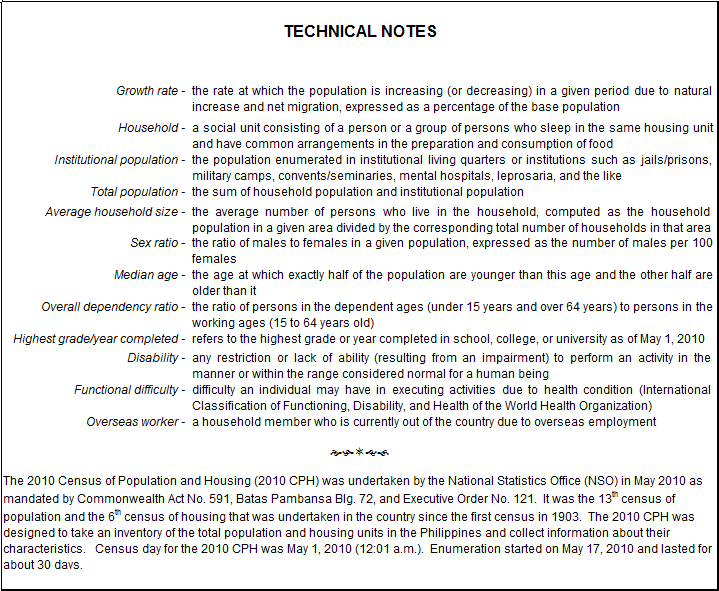Population of Pangasinan increased at the rate of 1.34 percent annually
Based on the 2010 Census of Population and Housing (CPH), the province of Pangasinan posted a total population of 2,779,862 persons as of May 1, 2010. This is larger by 345,776 persons compared to its total population of 2,434,086 persons counted in the 2000 CPH. The increase in the population count from 2000 to 2010 translated to an average annual population growth rate (PGR) of 1.34 percent. This is lower than the 1.87 percent annual PGR of the province between the census years 1990 and 2000.
If the average annual PGR recorded at 1.34 percent during the period 2000 to 2010 continues, the population of Pangasinan would double in 52 years.
Fifty years ago, the population of Pangasinan was only 1,124,144 persons. This population size is less than half of the population of the province in the 2010 CPH.
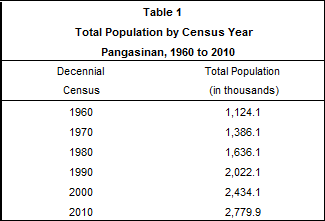
San Carlos City was the most populous
Among the four cities and 44 municipalities comprising the province of Pangasinan, San Carlos City was the most populous with a population size making up 6.3 percent of the total provincial population. Dagupan City was second with 5.9 percent share, followed by the city of Urdaneta (4.5 percent), Malasiqui (4.4 percent), and Bayambang (4.0 percent). The rest of the city/municipalities contributed less than 4.0 percent each.
The least populated area was the municipality of Santo Tomas with 0.5 percent share to the total population of the province. It was also the least populated area in 2000.
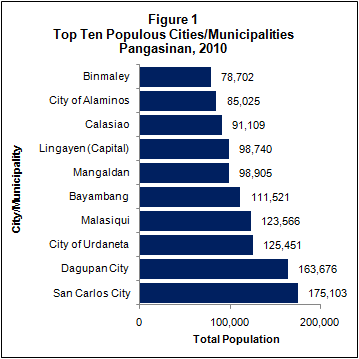
Sex ratio was 102 males per 100 females
Of the 2,777,449 household population in 2010, males accounted for 50.5 percent while females comprised 49.5 percent. These figures resulted in a sex ratio of 102 males for every 100 females, which is similar to the sex ratio recorded in 2000 (101 males per 100 females).
Median age increased to 23.9 years
In 2010, the median age of the population of the province was 23.9 years, which means that half of the population was younger than 23.9 years. This is higher than the median age of 21.6 years that was recorded in 2000.
Moreover, approximately one in every three persons (33.0 percent) was under 15 years old. Children aged 5 to 9 years (11.1 percent) comprised the largest age group, followed by those in the age groups 10 to 14 years (11.0 percent) and 0 to 4 years (10.9 percent). Males outnumbered females in the age groups 0 to 54 years. On the other hand, there were more females than males in the older age groups (55 years and over).
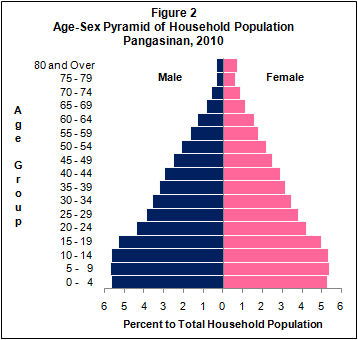
About three fifths of the population were of voting age
The voting-age population (18 years and over) accounted for 60.7 percent of the household population in 2010, up from 57.0 percent in 2000. There were more females (50.3 percent) than males (49.7 percent) among the voting-age population.
Dependency ratio decreased to 63 dependents per 100 persons in the working age group
In 2010, the young dependents (0 to 14 years) comprised 32.9 percent of the household population while the old dependents (65 years and over) posted a share of 5.5 percent. The working-age population (15 to 64 years) accounted for the remaining 61.5 percent.
The overall dependency ratio was 63, which indicates that for every 100 working-age population, there were about 63 dependents (53 young dependents and 10 old dependents). This ratio is lower than the dependency ratio in 2000, which was recorded at 71 dependents per 100 working-age population (63 young dependents and eight old dependents).
There were more males than females among the never-married persons
Of the household population 10 years old and over, 46.8 percent were married while 42.3 percent were never married. The rest of the population were categorized as follows: in common-law/live-in marital arrangement (4.6 percent), widowed (5.2 percent), and divorced/separated (1.1 percent).
Among the never-married persons, 54.7 percent were males while 45.3 percent were females. For the rest of the categories for marital status, the females outnumbered the males.
More females had attained higher levels of education
Of the household population aged five years and over, 31.3 percent had attended or completed elementary education, 40.7 percent had reached or finished high school, 8.0 percent were college undergraduates, and 9.6 percent were academic degree holders. Among those with an academic degree, the females (56.6 percent) outnumbered the males (43.4 percent). Similarly, more females (64.8 percent) than males (35.2 percent) had pursued post baccalaureate courses.
Persons with disability comprised 1.6 percent of the population in the province
In 2010, around 44,200 persons or 1.6 percent of the 2,777,449 household population had a disability. This proportion of persons with disability (PWD) is higher than the proportion in 2000, which was 1.1 percent of the 2,432,128 household population of the province during that year. The number of PWD for the same year was around 27,200.
There were more females than males among those with functional difficulty
Of the 2,473,956 household population five years and over, 3.3 percent (81,636 persons) had at least one type of functional difficulty either in seeing, hearing, walking or climbing steps, remembering or concentrating, self-caring (bathing or dressing), or communicating. There were more females (54.9 percent) than males (45.1 percent) among those persons with at least one type of functional difficulty.
Moreover, of the total 81,636 persons aged five years and over with at least one type of functional difficulty, 67.7 percent reported difficulty in seeing, even if wearing eyeglasses. There were 25.1 percent who had difficulty in hearing, even if using a hearing aid, 25.1 percent had difficulty in walking or climbing steps, 14.4 percent had difficulty in remembering or concentrating, 12.1 percent had difficulty in communicating, and 10.5 percent had difficulty in self-caring (bathing or dressing).
Female overseas workers outnumbered their male counterparts
Of the 2,165,833 household population 10 years old and over in Pangasinan, 3.0 percent (64,106 persons) were overseas workers. Female overseas workers outnumbered their male counterparts as they comprised 51.2 percent of all the overseas workers from this province. Overseas workers aged 45 years and over made up the largest age group, comprising 23.7 percent of the total overseas workers from this province in 2010, followed by the age groups 30 to 34 years (18.2 percent), 35 to 39 years (17.3 percent) and 25 to 29 years (16.7 percent).
Average household size was 4.5 persons
The number of households in 2010 was recorded at 612,553, higher by 134,734 households compared with the 477,819 households posted in 2000. The average household size in 2010 was 4.5 persons, lower than the average household size of 5.1 persons in 2000.

There were 103 households per 100 occupied housing units
A total of 593,567 occupied housing units were recorded in Pangasinan in 2010. This translates to a ratio of 103 households for every 100 occupied housing units, with 4.7 persons per occupied housing unit. In 2000, there were 102 households per 100 occupied housing units and 5.2 persons per occupied housing unit.
Occupied housing units with outer walls and roofs made of strong materials increased
In 2010, more than half (54.9 percent) of the occupied housing units in the province had outer walls made of concrete/brick/stone, up from 37.9 percent in 2000. The proportion of occupied housing units with outer walls made of bamboo/sawali/cogon/nipa, on the other hand, decreased from 29.2 percent in 2000 to 18.7 percent in 2010. Meanwhile, majority (85.8 percent) of the occupied housing units in 2010 had roofs made of galvanized iron/aluminum. This is higher than the proportion recorded in 2000 at 77.5 percent.
Majority of the households lived in lots that they owned or amortized
In 2010, of the total 612,553 households, 77.6 percent owned or amortized the lots that they occupied. The corresponding figure in 2000 was lower at 68.1 percent.
Moreover, 17.5 percent of the households occupied lots which were rent-free but with consent of the owner, 3.5 percent rented the lots that they occupied while 0.8 percent occupied lots which were rent-free but without consent of the owner.
